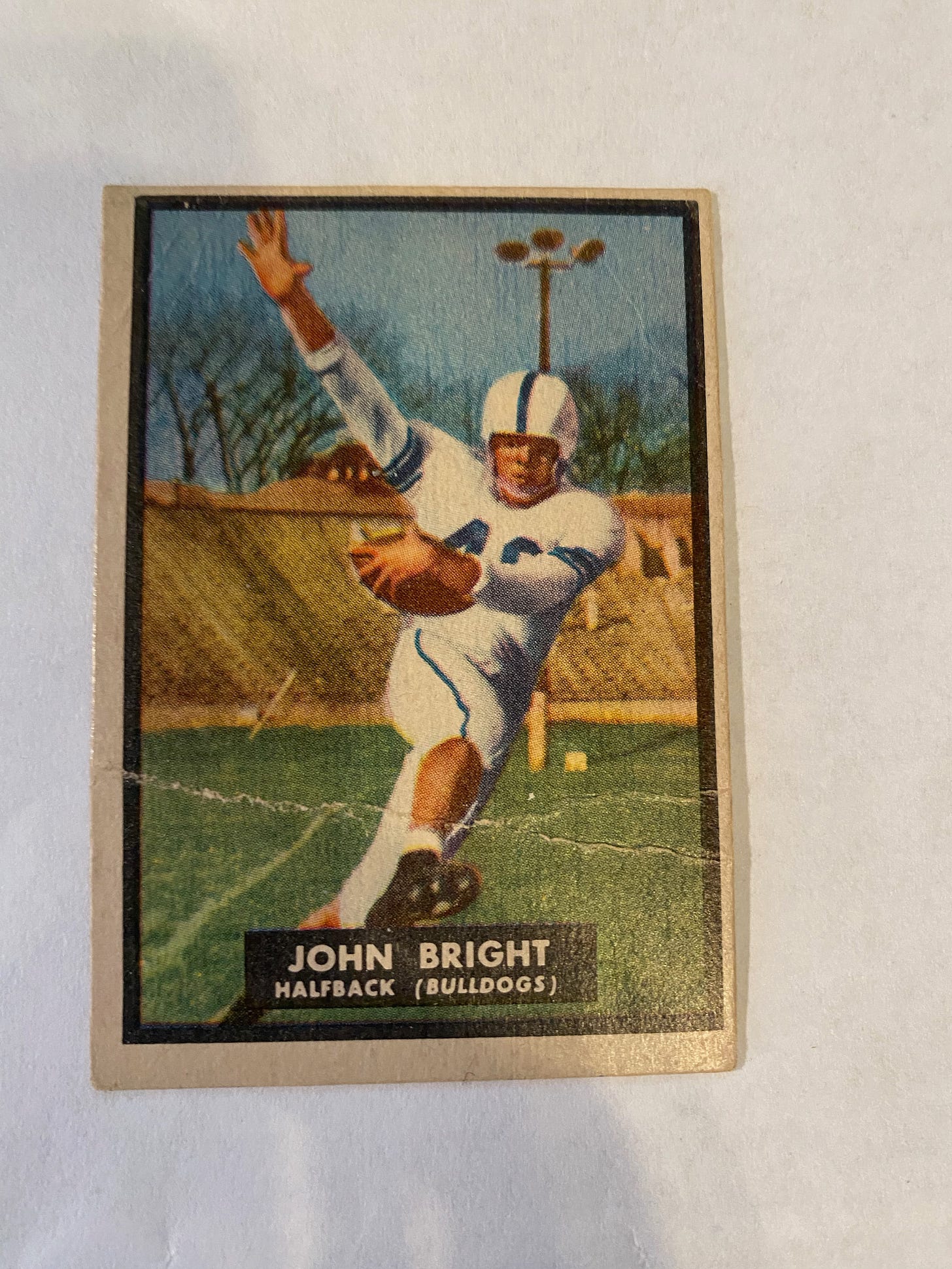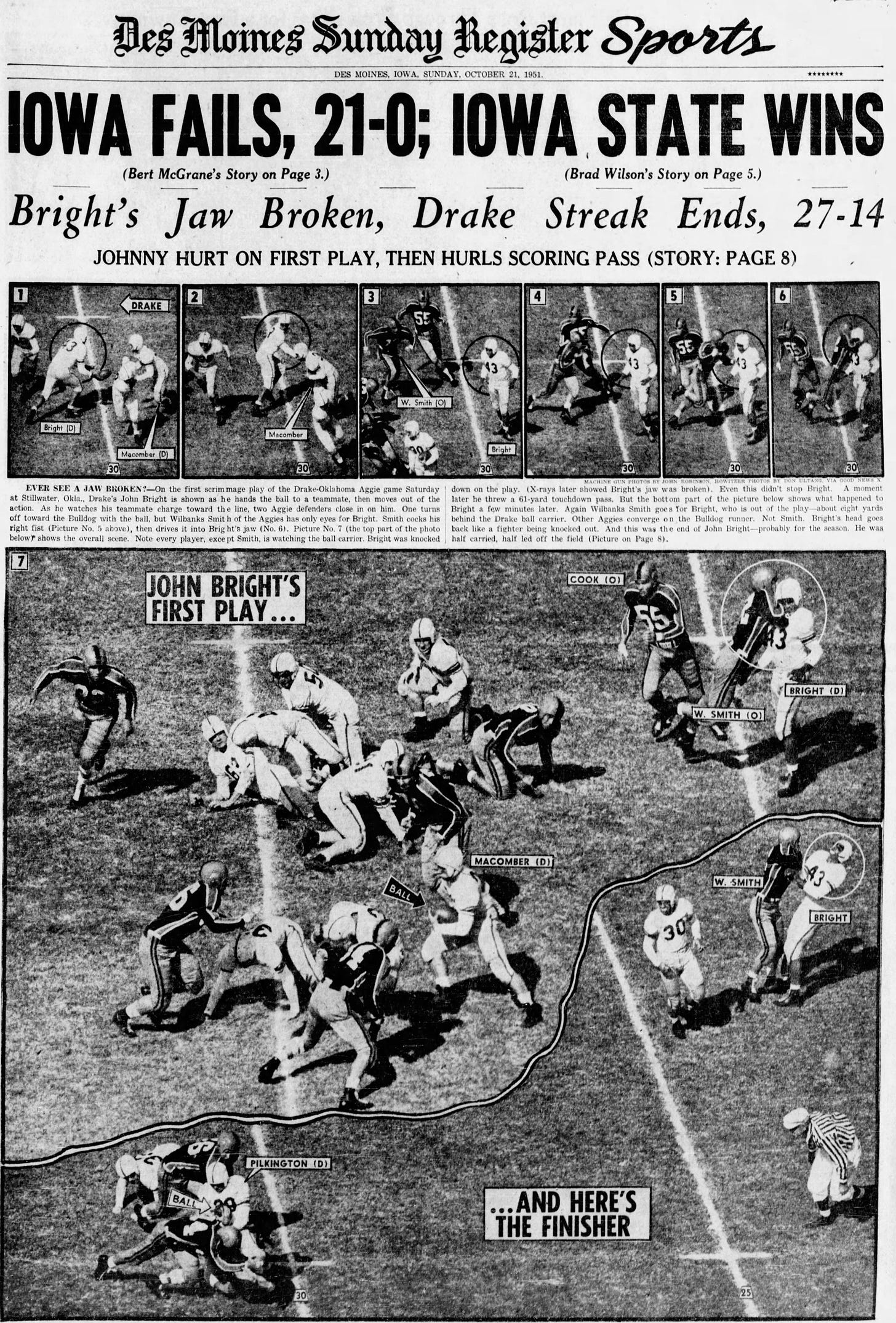A brutal attack on a Black player occurred during a college football game 70 years ago. Why don't we remember?
Drake's Johnny Bright had his jaw broken
Seventy years ago last week, October 20 1951, a Heisman candidate from a small school in Des Moines, Iowa was brutally attacked on the football field. It was an anniversary that passed without recognition or acknowledgment from national college football writers. Even I had forgotten about it until my former boss added some links to a group email (thank you, Mike, for not letting it pass). Why is our memory of events like these so fleeting?
Johnny Bright was a dual-threat quarterback and the first legitimate African-American Heisman candidate, 10 years before Ernie Davis of Syracuse would win the award. From Fort Wayne, Ind., Bright had helped Drake University to a 5-0 record when it traveled to Stillwater, Oklahoma to play Oklahoma A&M (now Oklahoma State). Bright and Drake had played there in 1949, the first time a Black player had competed at Lewis Field.
Early in the game, Bright handed the ball to his fullback while Oklahoma A&M defensive lineman Wilbanks Smith ignored the ball and went straight for Bright, slamming his right forearm into Bright’s jaw. This happened not once, but twice on separate plays. The Des Moines Register captured the event in a series of photographs which ran on the front page of the sport section. The visual evidence of the blatant assault won the paper’s photographers Don Ultang and John Robinson a Pulitzer Prize. Both Life magazine and the New York Times reprinted the photos.
Branson Wright summarized the event’s aftermath for a December 2017 piece at The Undefeated. As Wright noted, the event not only accelerated the adoption of face masks, but it also was used during the civil rights movement of the 1950s. Wright interviewed Smith who denied the incident was racially motivated. Smith told writer Berry Tramel of the Oklahoman in 2006 that he did not regret hitting Bright, but also maintained it was not racially motivated. He took the same position in 2012 during a video interview for a short documentary directed by Adam Cooper Kemp and titled “Without Rules: The Untold Story of the Johnny Bright Incident.” It is available on YouTube.
The two schools involved in this incident have gone their separate ways. Drake, my alma mater, is no longer a college football power. I worked in the athletic department as an undergraduate and graduate student and, thanks to my interactions with the legendary Paul Morrison, knew of Johnny Bright. To suggest Drake was a football power at some point requires a broad definition of power, though it is true, however, that in the early 1900s, Drake competed toe-to-toe with Iowa State, Nebraska, and Missouri, as part of the precursors to the Big Eight conference. When the larger state schools formed the Big Six in 1927, Drake went with Grinnell, Washington University of St. Louis, and Oklahoma A&M to form the Missouri Valley Conference.
While Drake today remains a mid-sized private university with a $17 million athletic budget, Oklahoma A&M became Oklahoma State and regularly goes toe-to-toe with top college football powers. It spends nearly $25 million per year on its football program and plays its games at Boone Pickens Stadium, named for the individual who gave OSU athletics nearly $300 million between 2003-08.
Despite being drafted in the first round by the Philadelphia Eagles in the 1952 NFL draft, Bright opted to play in Canada. While he never said it publicly, the sense is the more receptive racial climate north of the border made Canada more attractive than the NFL. Future Iowa State head coach Jim Walden was a teammate of Bright’s with Edmonton. He told Brandon Cleaver of the Des Moines Register in 2006, Bright “was as big to Canadian football as an early version of Johnny Unitas of the NFL.”
Oklahoma State provided an official apology for the incident in early 2006, prior to Drake dedicating “Johnny Bright Field” on September 30, 2006. Smith, who passed away on January 14, 2020, never apologized, continuing to deny any racial motivations in his hits on Bright.
Why does our collective memory not pay this incident attention? Will individuals say, like Smith did, that was how football was played in 1951? Sure. But what will those same individuals say about Oklahoma A&M denying Bright a place to stay in 1951?
Oklahoma A&M had grudgingly integrated in '49, admitting Nancy Randolph Davis under dubious conditions. The Guthrie hotel where Drake and Bright had stayed in '49 would not allow Bright this time, and while A&M offered dorms for the Drake squad, the invitation was not extended to Bright. - Berry Tramel, Oklahoman, Feb. 24, 2006
Historical incidents such as this one do eventually fade from public conscience, though the facts of the incident should not. Bright was a star Black college football player, deliberately targeted in a violent incident at a time of heightened racial tensions in the American South. The images of that day are clear.
Would Bright have become one of the NFL’s first Black superstars, had he chosen to play in Philadelphia? Drafted five years before Jim Brown, Bright played mostly running back during his CFL days with the Calgary Stampeders and Edmonton Eskimos, surpassing the 1,000-yard mark in five straight seasons. He was elected to the CFL Hall of Fame in 1970.
Bright’s legacy and impact on college football should not go unnoticed. Here’s hoping GameDay or some other college football media elites remember Bright next year, on the 71st anniversary of the incident, and that they continue to do so each subsequent year.




